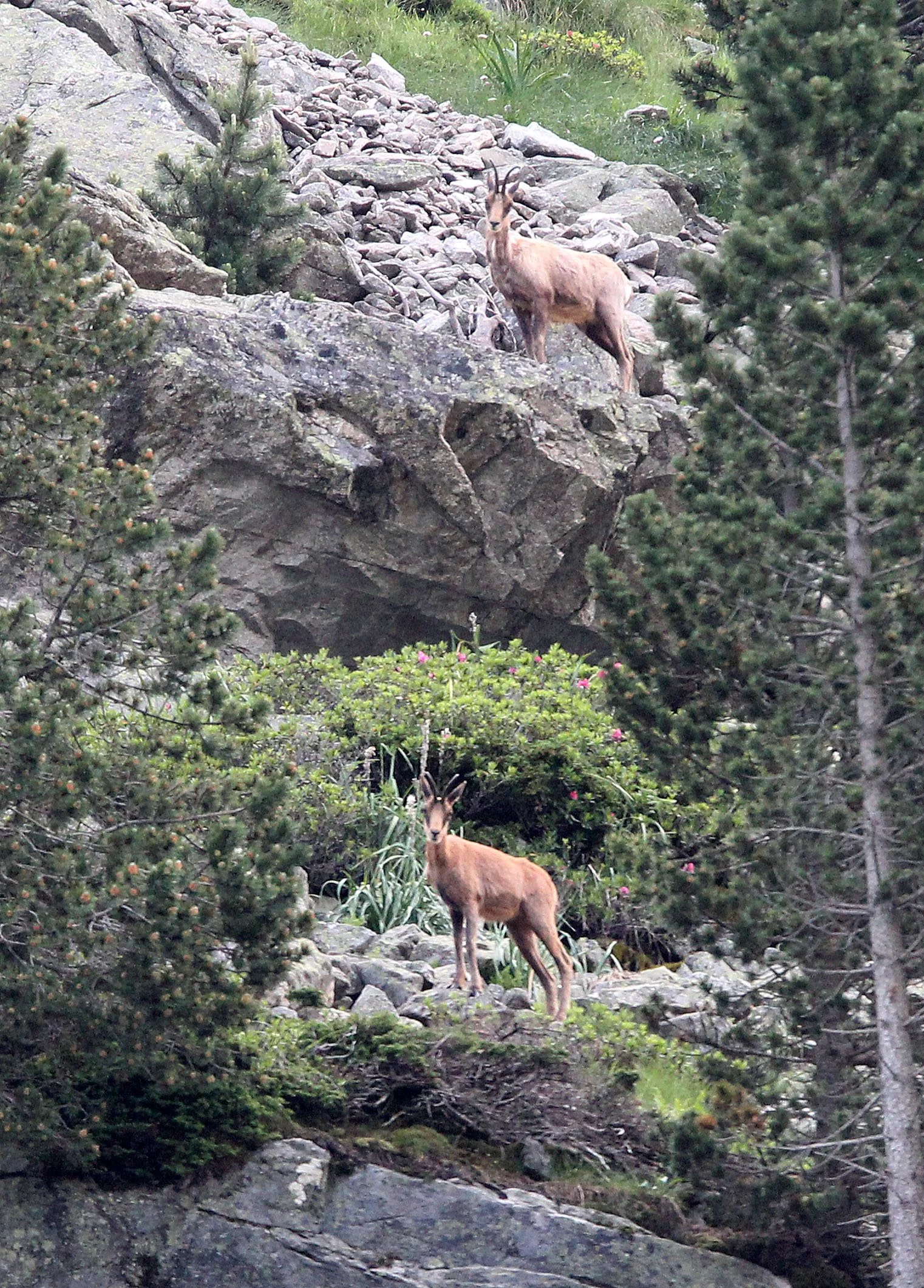
Rupicapra is a genus of goat-antelope called the chamois. They belong to the bovine family of hoofed mammals, the Bovidae.
Two extant species are recognized and have galleries below:
(Rupicapra rupicapra) Alpine chamois in the mountains of southern and central Europe and Turkey and the Caucasus.
In southwest Asia (Rupicapra pyrenaica) Pyrenean chamois the Pyrenees (a mountain range in southwestern Europe) and Apennines
The Apennine chamois (Rupicapra pyrenaica ornata) is a subspecies of the Pyrenean chamois, a goat-like mammal found in the mountains of Europe. Both male and female have hook-shaped horns that slightly curl backwards and grow little by little each year, never falling off. Their coats are light brown in the summer and darker in the winter, with a light colored mark on the throat. There are also two darker bands on their flanks.
In the summer, the Apennine chamois prefers rock faces and pasture lands at heights above 1700 meters for its habitat, and in the winter it prefers to retreat to the woods below. Diet of the chamois consists of grasses, leaves, buds, shoots and fungi. Adult males prefer a solitary life, only approaching females during the mating season. Groups consist only of females, young males, and "kids." Females give birth to only one kid after a gestation period of 23 to 24 weeks.
A 2014 study by Durham University discovered that these goats are shrinking in size due to global warming and climatic changes.
Apennine Chamois (Rupicapra ornata) - Abruzzo National Park, Italy (I am treating it as a full species)

























































































































The Chamois (Rupicapra rupicapra) or Alpine Chamois is a species of goat-antelope native to mountains in Europe, from west to east, including the Alps, the Dinarides, the Tatra and the Carpathian Mountains, the Balkan Mountains, the Rila–Rhodope massif, Pindus, the northeastern mountains of Turkey, and the Caucasus. The chamois has also been introduced to the South Island of New Zealand. Some subspecies of chamois are strictly protected in the EU under the European Habitats Directive.
Female chamois and their young live in herds of up to 15 to 30 individuals; adult males tend to live solitarily for most of the year. During the rut (late November/early December in Europe, May in New Zealand), males engage in fierce battles for the attention of unmated females. An impregnated female undergoes a gestation period of 170 days, after which a single kid is usually born in May or early June. On rare occasions, twins may be born. If a mother is killed, other females in the herd may try to raise the young.[7] The kid is weaned at six months of age and is fully grown by one year of age. However, the kids do not reach sexual maturity until they are three to four years old, although some females may mate at as early two years old. At sexual maturity, young males are forced out of their mother's herds by dominant males (who sometimes kill them), and then wander somewhat nomadically until they can establish themselves as mature breeding specimens at eight to nine years of age.
Chamois eat various types of vegetation, including highland grasses and herbs during the summer and conifers, barks and needles from trees in winter. Primarily diurnal in activity, they often rest around mid-day and may actively forage during moonlit nights.
Chamois can reach an age of 22 years in captivity, although the average recorded age in the wild ranges from 15 to 17 years. Common causes of mortality can include avalanches, epidemics and predation. At present, humans are the main predator of chamois. In the past, the principal predators were Eurasian lynxes, Persian leopards and gray wolves; with some predation possibly by brown bears and golden eagles. Chamois usually use speed and stealthy evasion to escape predators and can run at 50 kilometers per hour (31 mph) and can jump 2 m (6.6 ft) vertically into the air or over a distance of 6 m (20 ft).
The chamois is native to the Pyrenees, the mountains of south and central Europe, Turkey, and the Caucasus. It lives in precipitous, rugged, rocky terrain at moderately high elevations of up to at least 3,600 m (11,800 ft). In Europe, the chamois spends the summer months in alpine meadows above the tree line, but moves to elevations of around 800 m (2,600 ft) to spend the winter in pine-dominated forests.
Alpine Chamois (Rupicapra rubicapra rubicapra) - Stelvio National Park, Italy




























































The Pyrenean chamois (Rupicapra pyrenaica) is a goat-antelope that lives in the Pyrenees & Cantabrian Mountains of Spain, France & Andorra, and the Apennine Mountains of central Italy. It is one of the two species of the genus Rupicapra, the other being the chamois, Rupicapra rupicapra.
Spanish: rebeco, gamuza
French: izard/isard
Image Subspecies Distribution R. p. pyrenaica (Pyrenean chamois) France and Spain R. p. parva (Cantabrian chamois) Spain R. p. ornata (Abruzzo chamois)Central and southern Italy
Up to 80 cm tall, its summer coat is a ruddy brown; in winter, it is black or brown, with darker patches around the eyes. Both males and females have backward-hooked horns up to 20 cm in length. They browse on grass, lichens and buds of trees. Sure-footed and agile, they are found on any elevation up to 3000 m.
Like other species of chamois, it was hunted almost to extinction, especially in the 1940s, for the production of chamois leather. The population has since recovered, and in 2022 was estimated to be about 50,000 mature individuals.
Pyrenean Chamois (Rupicapra pyrenaica) - Arrens Marsous Pyrenees National Park, France




























































